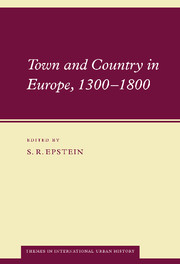Book contents
- Frontmatter
- Contents
- List of figures
- List of tables
- Notes on the contributors
- 1 Introduction. Town and country in Europe, 1300–1800
- 2 Town and country in Sweden, 1450–1650
- 3 Town and country in Holland, 1300–1550
- 4 Town and country in the Dutch Republic, 1550–1800
- 5 Town and country in England, 1300–1570
- 6 Town and country in England, 1570–1750
- 7 Town and country in the Polish Commonwealth, 1350–1650
- 8 Town and country in the Austrian and Czech lands, 1450–1800
- 9 Town and country in Germany, 1350–1600
- 10 Town and country in Switzerland, 1450–1750
- 11 Town and country in France, 1550–1750
- 12 Town and country in Castile, 1400–1650
- 13 Town and country in central and northern Italy, 1400–1800
- 14 Town and country in the kingdom of Naples, 1500–1800
- Index
4 - Town and country in the Dutch Republic, 1550–1800
Published online by Cambridge University Press: 09 November 2009
- Frontmatter
- Contents
- List of figures
- List of tables
- Notes on the contributors
- 1 Introduction. Town and country in Europe, 1300–1800
- 2 Town and country in Sweden, 1450–1650
- 3 Town and country in Holland, 1300–1550
- 4 Town and country in the Dutch Republic, 1550–1800
- 5 Town and country in England, 1300–1570
- 6 Town and country in England, 1570–1750
- 7 Town and country in the Polish Commonwealth, 1350–1650
- 8 Town and country in the Austrian and Czech lands, 1450–1800
- 9 Town and country in Germany, 1350–1600
- 10 Town and country in Switzerland, 1450–1750
- 11 Town and country in France, 1550–1750
- 12 Town and country in Castile, 1400–1650
- 13 Town and country in central and northern Italy, 1400–1800
- 14 Town and country in the kingdom of Naples, 1500–1800
- Index
Summary
Introduction
The sixteenth and the first half of the seventeenth century was a period of expansion for most Dutch towns. By 1650, approximately 42 per cent of the almost 2 million inhabitants of the northern Netherlands lived in towns numbering at least 2,500. Urban concentrations were strongest in the maritime western provinces; in the province of Holland alone, which included about two-fifths of the total Dutch population, the proportion living in towns came to 61 per cent. Although inland the population was less concentrated, the overall rate of urbanisation (taking 2,500 as the urban threshold) was still between 20 and 30 per cent.
Most historians link seventeenth-century Dutch wealth and power to the simultaneous rise of trade and the political co-operation of Holland's urban elites. The countryside is seen as being carried along with the towns, with a similar display of rising commercialisation and specialisation and a general increase in labour productivity. What this picture leaves out is the relation between town and country and, more specifically, the control exerted by Dutch towns over their surrounding countryside. Most urban histories treat the towns as if they were islands and leave out the surrounding hinterland, whereas agrarian historians generally evade the issue of urban control. Both the dominance of urban elites in ‘high politics’ and the countryside's prosperity are taken for granted, even though the extensive privileges and political rights towns were often directed against rural trade and industry.
- Type
- Chapter
- Information
- Town and Country in Europe, 1300–1800 , pp. 80 - 105Publisher: Cambridge University PressPrint publication year: 2001
- 2
- Cited by

